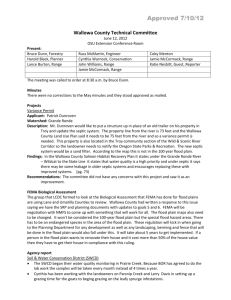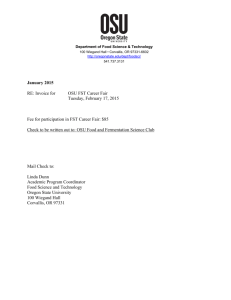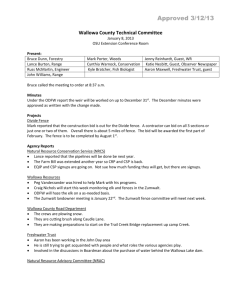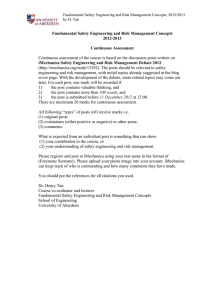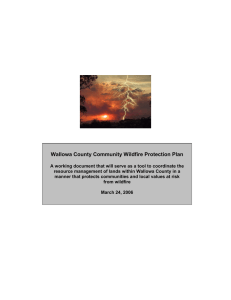Enclosure 4A - Project Summary Form 541-737-4222 541-737-3385
advertisement
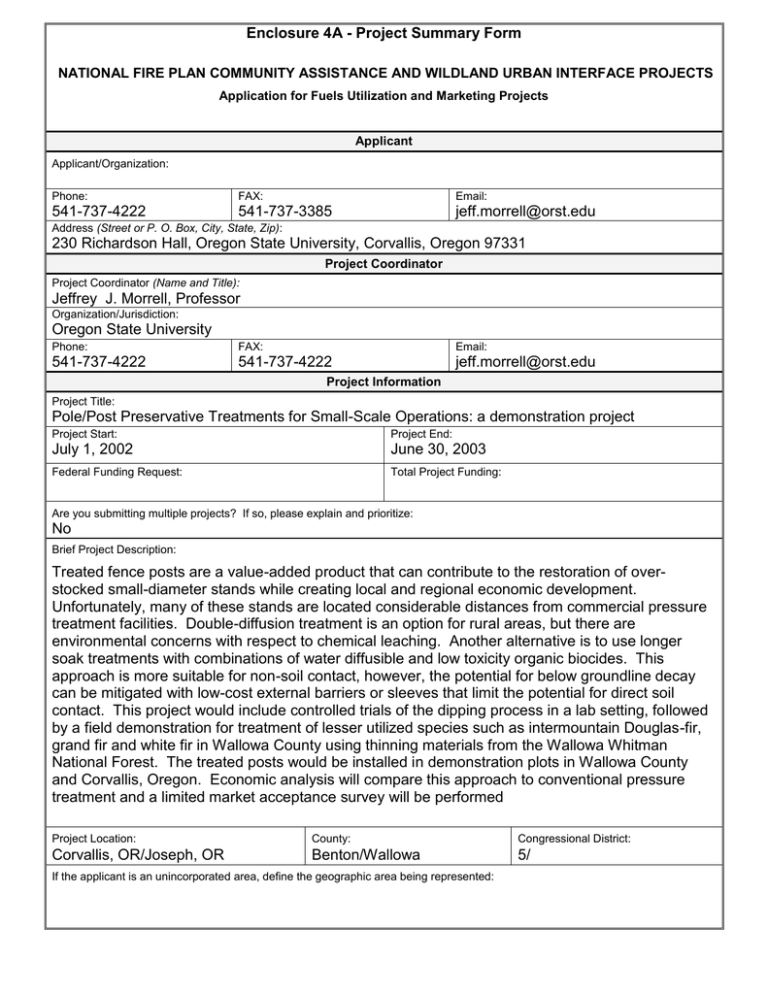
Enclosure 4A - Project Summary Form NATIONAL FIRE PLAN COMMUNITY ASSISTANCE AND WILDLAND URBAN INTERFACE PROJECTS Application for Fuels Utilization and Marketing Projects Applicant Applicant/Organization: Phone: FAX: Email: 541-737-4222 541-737-3385 jeff.morrell@orst.edu Address (Street or P. O. Box, City, State, Zip): 230 Richardson Hall, Oregon State University, Corvallis, Oregon 97331 Project Coordinator Project Coordinator (Name and Title): Jeffrey J. Morrell, Professor Organization/Jurisdiction: Oregon State University Phone: FAX: Email: 541-737-4222 541-737-4222 jeff.morrell@orst.edu Project Information Project Title: Pole/Post Preservative Treatments for Small-Scale Operations: a demonstration project Project Start: Project End: July 1, 2002 June 30, 2003 Federal Funding Request: Total Project Funding: Are you submitting multiple projects? If so, please explain and prioritize: No Brief Project Description: Treated fence posts are a value-added product that can contribute to the restoration of overstocked small-diameter stands while creating local and regional economic development. Unfortunately, many of these stands are located considerable distances from commercial pressure treatment facilities. Double-diffusion treatment is an option for rural areas, but there are environmental concerns with respect to chemical leaching. Another alternative is to use longer soak treatments with combinations of water diffusible and low toxicity organic biocides. This approach is more suitable for non-soil contact, however, the potential for below groundline decay can be mitigated with low-cost external barriers or sleeves that limit the potential for direct soil contact. This project would include controlled trials of the dipping process in a lab setting, followed by a field demonstration for treatment of lesser utilized species such as intermountain Douglas-fir, grand fir and white fir in Wallowa County using thinning materials from the Wallowa Whitman National Forest. The treated posts would be installed in demonstration plots in Wallowa County and Corvallis, Oregon. Economic analysis will compare this approach to conventional pressure treatment and a limited market acceptance survey will be performed Project Location: County: Congressional District: Corvallis, OR/Joseph, OR Benton/Wallowa 5/ If the applicant is an unincorporated area, define the geographic area being represented: Enclosure 4B (Page 1 of 3) - Project Narrative Description Applications for funding must include a narrative response that describes the proposal. Please do not submit responses longer than one page, single space, 12-pitch font. Describe project including, but not limited to: project location project income Address these project implementation project time frames items as anticipated outcomes specify types of activities and equipment used applicable: measures and reporting amount or extent of actions (acres, number of homes, etc) partners environmental, cultural and historical resource requirements Response: Thinning is a critical tool for restoring forest health in many parts of the Intermountain West. However, thinning produces low value material that has limited markets. One product of small diameter logs that has potential is fence posts. Fence posts are low cost materials, and can be made from virtually any wood species. They can be made locally, creating both a value added product and local employment. The limiting factor to the fence post production is access to pressure treating facilities near areas in need of thinning. Dip or soaking processes can be substituted, but these processes result in less well-protected materials. Double diffusion (Cu/F) has been proposed as a method for impregnating posts with minimal equipment investment, but this process has drawbacks. The process requires two separate chemical treatments and a post treatment diffusion period. In addition, fluoride is not currently labeled with the US. EPA for this application and the solutions can be corrosive, complicating treatment. Finally, the metal component is not strongly fixed in the wood and can migrate from the wood. The furor over chromated copper arsenate (CCA) treated wood stems from component mobility. We will demonstrate an alternative post treatment system using less toxic biocides with minimal equipment investment. The system will use low toxicity organic biocides such as triazole fungicides in combination with a water diffusible component (boron). Triazoles are well known for the specificity to fungi and have minimal effects on higher organisms at the levels used. Boron has a long history of use as an insecticide. These chemicals work well in above ground exposures, but perform poorly in ground contact. To overcome this problem, the below-ground portion of each post can be wrapped in a plastic barrier. Plastic barriers have been used for many years in other applications. Screening tests at OSU show that plastic barriers substantially reduced decay of pine stakes in soil contact. We will identify a UV stable plastic that can be heat sealed to the bottom of the posts and resists tearing during installation. Phase I of the project will take place at the OSU Dept of Wood Science and Engineering to assess chemical uptake and treatment times for various target solutions. Once the preferred solutions have been identified, a field trial will take place in Wallowa County. Posts, harvested and peeled locally will be treated, with measurements taken on treatment time, weight gain, and treatment penetration. External plastic wraps will be applied and provided to local contractors for trial use. Posts will also be installed in the OSU Post Farm in Corvallis where performance can be monitored under more aggressive decay conditions. Treatment economics will be assessed using cost data for the chemical used, the plastic barriers, and personnel time required for treatment. This information will be compared with treatment costs at the closest commercial facility, including transportation costs. The analysis will determine cost:benefit ratios for local treatment using this new method versus outsourcing Costs associated with post preparation and procurement will be ignored since they should not differ between the two processes. In addition, we will perform a limited market acceptance survey to assess the attitudes of potential users of these products The project goal is to establish a program that could be applied to other small timber dependent communities to utilize small diameter timber in a value added product that creates local employment. The results will be summarized in a user guide for developing treatment operations. Enclosure 4B (Page 2 of 3) - Project Evaluation Criteria Applications for funding must include narrative responses that address the following four criteria. Within each criterion, subcriteria are listed in descending order of importance. Limit your responses to the areas provided. 1. Increasing Local Capacity (35 Points) A. How would the proposal improve or lead to the improvement of the local economy in terms of jobs and sustainable economic activity? How many jobs are expected to be created or retained and for how long (please distinguish between essentially year-round and seasonal jobs)? B. Will biomass or forest fuels be utilized; if so, in what manner and how much? C. Which, if any, private businesses will participate? D. To what extent will this project be offered to serve as a model for other communities or businesses? Response: A. The project has the potential for improving the local economy byproviding local employment for harvesting and preparation of post material for treatment. The project also offers the potential for retaining more money in the local economy since posts will not need to be purchased from other areas, and has thepotential for bringing in in additional money as markets for treated posts develop outside the local area. B. Small diameter materials will be the primary focus of the project- this should reduce fuel levesl while providng more of an economic stimulus for thinnning. C. Wallowa Resources will be the primary local participant in the demonstration, although we will invite other local business to participate in the project D. We intend to document the costsa nd benefits of this project and then prepare a guide for other communities seeking similar projects. 2. Reducing fire risk. (30 points) Describe how the proposal promotes reduction of risk in high hazard areas and communities. Describe how the proposed project benefits resources on federal land or adjacent non-federal land, or how it protects the safety of communities. C. To what extent does the project implement or create a cooperative fuels treatment plan or community fire strategy (include evidence of the plan if it already exists)? D. Explain how the proposal (a) leads to, enhances or restores a local fire-adapted ecosystem, and/or (b) mitigates or leads to the mitigation of hazardous fuels conditions. A. B. Response: A. Creating markets for small diameter timber indirectly stimulates interest in thinning projects that can be used to reduce fule loads At present, the outlet for most small diameter thinning material is the chip market, which has depressed prices that provide little incentive for action. In addition, many forests are too far froml potential chip markets, making the process even less attractive. B. Th is project can benefit both federal and private land by proividng an incentive to remove over-stocked small diameter timber. This will reduce fuel loads, reducing the risk of catastrophic wildfires. C. The project provides an incentive for fuels reduction through thinning. D. Proviing economic incentives for removing small diameter timber should encourage managers to undertake restoration projects in areas where larger diameter timber may be lacking. This shouldhelp enhance the prospects for restoration fo a fire adapted ecosystem. Enclosure 4B (Page 3 of 3) - Project Evaluation Criteria 3. Increasing interagency and intergovernmental coordination. (15 Points) A. To what extent have interested people and communities been provided an opportunity to become informed and involved in this proposal? B. Describe the extent of local support for the project, including any cost-sharing arrangements C. What are the environmental, social and educational benefits of the project? Response: A&B. This proejct will provide a demonstration for local timber users through Wallowa Resources, a local group seeking to help develop new markets for materials from Northeastern Oregon forests. The model, however, will apply to nearly all communities in the Western U.S. C. The environment will hopefully benfit because thinning materials removed may stimulate recovery of the native fire-adapted forest. This project also offers the ptoential for developing stable local employment 4. Increasing interagency and intergovernmental coordination. (20 Points) A. Explain the level of cooperation, coordination or strategic planning among federal, state, tribal, local government and community organizations in developing this proposal. List the cooperators. B. Describe how this project implements a local intergovernmental strategy or plan, or creates such a plan. Describe the plan if it already exists. Response: This project represents a collaborative effort between a local organization (Wallowa Resources) and a State agency (OSU) to take research results developed at the University and apply these results to a real world problem. This approach offers the potetnial to leap ahead of existing practice to produce a technology for post treatment that is safe, practical, and cost-effective in a manner that allows the technology to be applied locally Enclosure 4C - Project Work Form Tasks Time Frame Responsible Party Identify suitable treatment regimes Months 1-3 OSU Field Demonstration of treatmentprocess Month 5 to 6 Wallowa Resources with OSU support Assess economics of treatment Month 7 OSU with Wallowa support Prepare treatment guide for other operations Months 8-12 OSU with Wallowa support Enclosure 4D - Project Budget Cost Category Description Federal Agency Applicant Partner 1 Personnel $6,263.00 $2,310.00 $3,000.00 Subtotal $6,263.00 $2,310.00 $3,000.00 Fringe Benefits $2,460.00 $831.00 Subtotal $2,460.00 $831.00 Travel $1,200.00 Subtotal $1,200.00 $0.00 $0.00 $0.00 Partner 2 Total $0.00 $11,573.00 $0.00 $0.00 $11,573.00 $0.00 $3,291.00 $0.00 $0.00 $3,291.00 $0.00 $1,200.00 $0.00 $0.00 $1,200.00 $0.00 $0.00 $0.00 $0.00 $0.00 $0.00 $600.00 $0.00 $0.00 $600.00 $0.00 $0.00 $0.00 $0.00 $0.00 Equipment Subtotal $0.00 Supplies $600.00 Subtotal $600.00 $0.00 $0.00 $0.00 $0.00 Contractual Subtotal $0.00 $0.00 $0.00 Other Indirect Costs (41.5%) $4,367.00 $1,304.00 Subtotal $4,367.00 $1,304.00 $0.00 $0.00 $0.00 $5,671.00 $0.00 $5,671.00 Total Costs $14,890.00 $4,445.00 $3,000.00 $0.00 $22,335.00 Project (Program) Income1 1 Program income is the gross revenue generated by a grant or cooperative agreement supported activity during the life of the grant. Program income can be made by recipients from fees charged for conference or workshop attendance, from rental fees earned from renting out real property or equipment acquired with grant or cooperative agreement funds, or from the sale of commodities or items developed under the grant or cooperative agreement. The use of Program Income during the project period may require prior approval by the granting agency. $0.00
